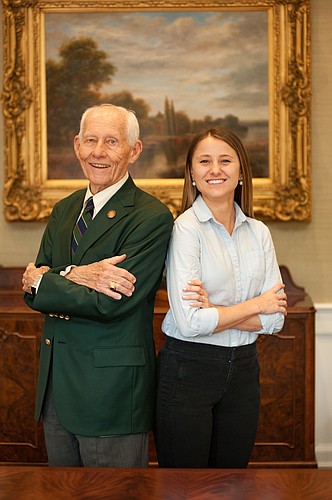- April 15, 2025
-
-
Loading

Loading

The age gap between two employees at Caldwell Trust Co. is huge. So big that the most senior employee was born when Franklin D. Roosevelt was president, while the youngest was a baby during the Clinton Administration.
But Lee Thacker Jr., 85, and Sarah Rothenbach, 23, co-exist in harmony at Venice-based Caldwell Trust, which both recently celebrated 25 years in business and surpassed $1 billion in assets under management. “Age is relative,” says Kelly Caldwell, president and CEO. “Old or young, values matter more than age. Do you understand and share our values? If you do, I can find a home for you here.”
'Try to stay away from stereotypes. There is a lot of misinformation out there. Not every millennial acts entitled.' Doug Van Dyke, Leadership Simplified
That doesn’t mean managing people from different generations in the same workplace is easy. Some of the keys to successful navigation of these generations — baby boomers, Generation X, Millennials and Generation Z — include management 101 staples, like transparency, communication and authenticity, says workplace coach Doug Van Dyke.
“We need to lead different people differently, while staying true to our values,” says Van Dyke, CEO of Bradenton-based Leadership Simplified. “We are in new territory here with four generations in the workplace. There’s not a textbook on this. There’s no manual.”
But there are some best practices. For one, empathy goes a long way — in any generation. With some millennials, says Van Dyke, it’s particularly important to be conversational, and use a softer tone. Humor is essential, too. Says Van Dyke: “Everyone loves to laugh.”
Van Dyke also stresses to focus on the individual. “Anytime you’re talking about a generation, by definition you’re talking about generalizations,” he says. “But you want to try and stay away from stereotypes. There is a lot of misinformation out there. Not every millennial acts entitled.”
Executives at Caldwell Trust, with offices in Venice and Sarasota, take a similar approach — for all generations. “Because we have clients of all ages we have to have staff that understands how to deal with all ages,” says Jan Miller, executive vice president and trust officer at Caldwell Trust.
Thacker’s been with the firm since 1996. He started as a client, coming in to the office to check with his advisors. But like many retirees, he was bored, and Thacker, with a degree in economics from Duke, who started in banking and financial services in 1959, liked the people at the firm. So he asked for a job and got one. Two decades later he’s a senior executive vice president, trust officer, secretary and valuable confidant to Kelly Caldwell on the firm’s strategic direction.
Thacker’s work ethic makes him easy to manage, firm officials say, and his focus rubs off. He goes to the gym at 5:30 a.m. every day, says Miller, and is in the office by 7:30, looking at his to-do list. “Everyone needs a sense of purpose,” Miller says. “He had a vision for his retirement and it was to be able to do things for other people.”
Kelly Caldwell, meanwhile, recognizes that even if it’s a generalization, the idea that people under 30 don’t have the same work ethic like Thacker is not made up entirely. “The greatest generation people will say ‘just tell me what to do and I’ll do it,’” says Caldwell, “but some other generations want to know why. They want to know, ‘why am I doing this?’ Sometimes it’s not enough to get paid, but they’re looking for some meaning in what they’re doing.”
That mostly describes Rothenbach, who started as an intern at Caldwell Trust while in college, and then, seeking to shed her gig waiting tables, was hired full-time. Now she’s a junior business analyst with the firm. She’s also an example of what Miller and Caldwell aim to do when hiring anyone, another key to being able to manage different generations successfully: Hire for talent, problem-solving and good people skills, then find a spot for them.
“She’s the epitome of a sponge,” Caldwell says. “She just wants to know. It’s real exciting to see this still exists in the world today. When you tell her something, you can see it in her eyes, how much she wants to learn.”
The wants-to-learn philosophy stretches back to Van Dyke’s analysis of how to manage multiple generations. “It takes a lifelong learner to be successful at this,” he says. “People stuck in their ways, people stuck in the mud will probably struggle. Leaders who can excel at this are leaders who come to it with an open mind.”
How to motivate people to meet sales goals
How to run an effective brainstorming session
How to get a business loan when you need one
Have a crisis to manage? Here's how
How to deliver potentially scary news to employees
How to go out on your own and leave a corporate gig and salary behind
How to launch a B-Corp that generates results
How to hire and train people fast
How to manage multiple generations in the workplace
How to provide exceptional service